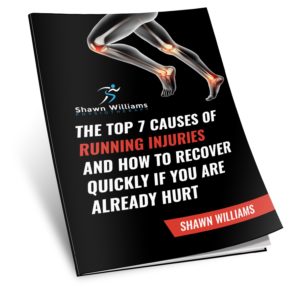Running is a great form of exercise that many fall in love with. However, some of you I am sure have started a running program only to have knee pain start and then have to stop. Many people who love running stop because every time they start a running program they have knee pain. With some basic tips and proper help it is possible for most people to enjoy a run along the Toronto Waterfront. Now that spring is here many will lace up and head out the door to run outside. Running, can be a great form of exercise for cardiovascular and mental health. If you are going to start a running program here are some tips to help prevent knee pain from running.
Progress Running Volume Slowly
If you are new to running this is probably one of the most important tips to prevent knee pain from running. If you are a beginner runner I recommend starting with a run walk program. This is one of the safest ways to build up your running so that you do not end up with a running injury. To prevent knee pain from running you should give yourself 6-8 weeks to get to the point where you can run for 30 minutes comfortably. Progressing quicker than this will mostly likely end up with either knee pain, hip pain, back pain, foot pain or some other soft tissue injury. Most beginner runners will get injured in the first 6 weeks of a running program. Whichever program you pick listen to your body. If you have pain post work out that is a sign you are pushing too hard and need to give your body more time to adapt.
Keep Up Your Running frequency
When starting a new running program it is important to keep your frequency up. It is more important to run shorter distance more frequently then running longer 1- 2 days per week. Studies show that runners which run 4- 6 days per week tend to get injured less. Running more frequently allows your tendons and muscles to adapt easier as long as you are increasing your volume slowly. It also allows for your running biomechanics to become more efficient, thus your muscles absorb the shock in the landing phase more efficiently. So in the beginning remember
Listen to your body
This is very important to learn when engaging in any running or physical activity program. When you start a running plan or even as an experienced runner. If you are increasing mileage and are in pain immediately after or the day after this is a sign you need to slow down on how quickly you are progressing you distance or speed. Patellofemoral syndrome or knee pain often starts off as slight discomfort around the knee cap and progresses until you feel pain with going up stairs, down stairs and eventually to the point where you have to stop running. Remember that there is no universal running program for everyone you need to adapt your program based on your body’s response. Listening to your body will help prevent knee pain with running and help you achieve your long term running and health goals.
Be careful when progressing Intensity.
Another way you can help to prevent knee pain from running is being careful how quickly you start increasing the intensity in your work outs. I do not recommend you do much speed training until you can run for 20-30 minutes continuous, comfortably 3 to 4 days per week without pain. This will ensure you have adequate base so that you can recover from speed workouts. For runners with less than 6 months of running experience you should be careful with doing more than one speed work out per week.
Stretching program
Stretching your legs and doing regular low back mobility post run can help to reduce the risk of knee pain form running by helping with maintain proper muscle balance. Before work outs I do not recommend static stretching. This type of stretching is where you hold for a set amount of time. This type of stretching should be performed after your work out. Before your work out you should focus more on warming up and dynamic stretching. You can check out a previous blog post: Should I Stretch Before Or After I Run?
Strengthening program
A strengthening program can be useful to prevent knee pain from running. One to two days per week can help keep muscles balanced. Doing some exercises that focus on the glutes, core and the legs can help keep runners from the side lines. Some key exercises to include are the side leg raise, the single leg bridge, plank, and controlled step up with good knee alignment. You can start with these exercises to help prevent knee pain from running.
Once You Can Run …Don’t Stop
This is my one piece of advice for all runners. Once you stop your running program, your body will start to lose its adaptation to running. The longer the time off the more you lose! If you take too much time off you will be basically be starting your base from scratch and will be at a higher risk for injury when you start running again. A week off is fine if you have a good base under you. If you start taking more than 2 weeks off I would gradually get back into running to help prevent knee pain from running or any other running injury.
Keep Your Cadence Up
Cadence is how many steps per minute you take. Generally runners that run at 170-190 steps per minute have less risk for injury. This is because there ground reaction force is lower and there running style is more efficient. Increasing your cadence will help prevent knee pain from running as well as the risk of most other running injuries.
Shoe Fit
In terms of shoes I would recommend going with a shoe with a heel to toe drop of less than 6 mm. Often I prescribe minimalist shoes to help runners run more efficiently and help to prevent knee pain with running. This is going to help keep your cadence up and allow your foot to react to the ground better and quicker. I would stay away from big bulky shoes or shoes with motion control devices. Do not fall for shoe selection based on shape of the foot while standing. This has no scientific evidence to support and often leads to over-prescription of motion control or increased stability shoes. The most important factor when selecting a shoe is that it fits well and feels comfortable. If you are interested in switching to a minimalist shoe you need to assure you progress very slowly into them as it will take time for your foot to adapt. I have helped hundreds of runners switch over into minimalist shoes. Contact Shawn Williams Physiotherapy for a free phone consultation if you have any questions about transitioning into a more minimalist foot ware.
Consult With a Hands On Physio
Consulting with a good hands on physiotherapist who understands running injuries can be a great addition to the above tips to help prevent knee pain with running or get you back on track if you are already experiencing knee pain. A good physiotherapist can educate you on a proper running program, shoe recommendation, and assess your biomechanics and risk factors for injuries running injuries. With an assessment from a physiotherapist who understands running injuries they can help you bullet proof your knees so that you spend less time being injured and more time running.
Spring is right around the corner and this is a time of year when many start running plans or get back to running. In this article I have mentioned a few key tips on how to prevent knee pain with running. However, if you are a beginner runner or competitive runner who gets injured frequently you may benefit from booking a Physiotherapy assessment with Shawn Williams Physiotherapy at 416-660-4187 to assess your readiness for running. If you are already injured then booking an assessment with a hands on physiotherapist who understands the injured runner is going to be your quickest way back to running. Shawn has over a decade experience helping runners recover from injury and get back outside running again.



